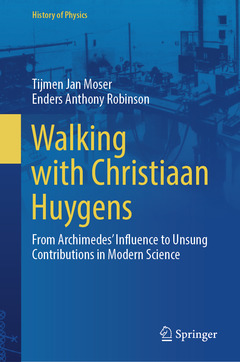Walking with Christiaan Huygens, 1st ed. 2024 From Archimedes' Influence to Unsung Contributions in Modern Science History of Physics Series
Auteurs : Moser Tijmen Jan, Robinson Enders Anthony

Dutch scientist Christiaan Huygens (1629-1695) left an indelible mark on the fields of mathematics, physics, astronomy, and geophysics. Despite his groundbreaking contributions, history has often overlooked his pivotal role. While two of the most famous achievements in physics are Newton?s theory of gravity and Einstein?s general theory of relativity, less well-known is that Huygens provided central elements to these theories. This book stands to correct that deficit. For example, we show how Huygens used symmetry arguments to derive conservation laws for momentum and for energy, and what Einstein later called the principle of equivalence to derive the formula for centrifugal force.
In 1689, Huygens visited Newton. Together, they walked the streets of London. Newton had recently finished his masterpiece, Principia, expounding his laws of motion and the law of universal gravitation. Huygens had essentially completed his life?s work by then, building on Archimedes, Leonardo da Vinci, Galileo, Descartes, Fermat, Pascal and his own ingenuity. He had established fame as an instrument maker (telescope, pendulum clock, planetarium). He had invented the 31 tone system. He had pioneered the first principles of remote sensing. He had discovered the rings of Saturn. He had formulated the wave theory of light. What would walking with Christiaan reveal? This book gives the result in nine chapters, namely: spontaneous order, the speed of light, Huygens? principle, the telescope, the pendulum clock, Huygens-Fresnel principle, special relativity, centrifugal force, and curvature. In addition, there is a chapter titled What Huygens could have written on diffraction, and a chapter titled Huygens and Geophysics. Mentally walking with Christiaan, browsing his collected works ? a true treasure trove for puzzle enthusiasts ? and rethinking his ideas creates a vivid impression of scientific life in the 17th century, an appreciation that it is remarkably similar to ours, and an understanding of Huygens' significant and lasting contributions to science.
1. Introduction.- Chapter 1. Historical overview of the life of Christiaan Huygens.- Chapter 2. Huygens and spontaneous order.- Chapter 3. Huygens and the speed of light.- Chapter 4. Huygens’ principle.- Chapter 5. Huygens and the telescope.- Chapter 6. Huygens and the clock.- Chapter 7. Huygens-Fresnel principle.- Chapter 8. Huygens and special relativity.- Chapter 9. Huygens and centrifugal force.- Chapter 10 Huygens and curvature.- Chapter 11. What Huygens could have written on diffraction.- Chapter 12. Huygens and geophysics.
Tijmen Jan Moser received his Ph.D. from the University of Utrecht, concentrating on the shortest-path method for seismic ray tracing. He has worked as a geophysical consultant for a number of companies and institutes, including Amoco, Institut Franc¸ais du Pe´trole, Karlsruhe University, Bergen University, Statoil/Hydro, Geophysical Institute of Israel, Fugro-Jason, and Horizon Energy Partners. Moser was an Alexander-von-Humboldt stipendiat 1996– 1997. Since 2005, he has been working independently with SGSHorizon, Seismik, and many other associations. Based in The Hague, The Netherlands, he is close to the former estate of Christiaan Huygens, whom he considers the greatest geophysicist of all time. Moser’s main interests include seismic imaging, asymptotic methods, seismic reservoir characterization, diffraction, and geothermal exploration. He has authored many influential papers on ray theory and ray methods, Born inversion and modeling, macro-model independent imaging, and diffraction imaging, several of which have received best paper awards, including an Honorary mention in 2005 from SEG and the Eo¨tvo¨s Award in 2007 and 2009 from EAGE. Moser has co-edited two reprint volumes for SEG, Classical and Modern Diffraction Theory and Seismic Diffraction, and teaches courses on diffraction for EAGE and SEG. He co-organizes the APSLIM (Active and Passive Seismics in Laterally Inhomogeneous Media) workshops in the Czech Republic (2015, 2021). He is a member of SEG and the Mathematical Association of America (MAA), an honorary member of EAGE, and Editor-in-Chief of Geophysical Prospecting.
Enders A. Robinson (1930 - December, 2022) was professor emeritus of geophysics at Columbia University in the Maurice Ewing and J. Lamar Worzel Chair. He received a B.S. in mathematics in 1950, an M.S. in economics in 1952, and a Ph.D. in geophysics in 1954, all from Massachusetts Institute of Technology. As a research assistant in the mathem
Puts the contributions of Huygens to modern science in an up-to-date context
Addresses the mystery why Huygens did not consider diffraction, although he had the unique tools to study it
Highlights the importance of Huygens’ principle for wave propagation in all branches
Date de parution : 04-2024
Ouvrage de 313 p.
15.5x23.5 cm


